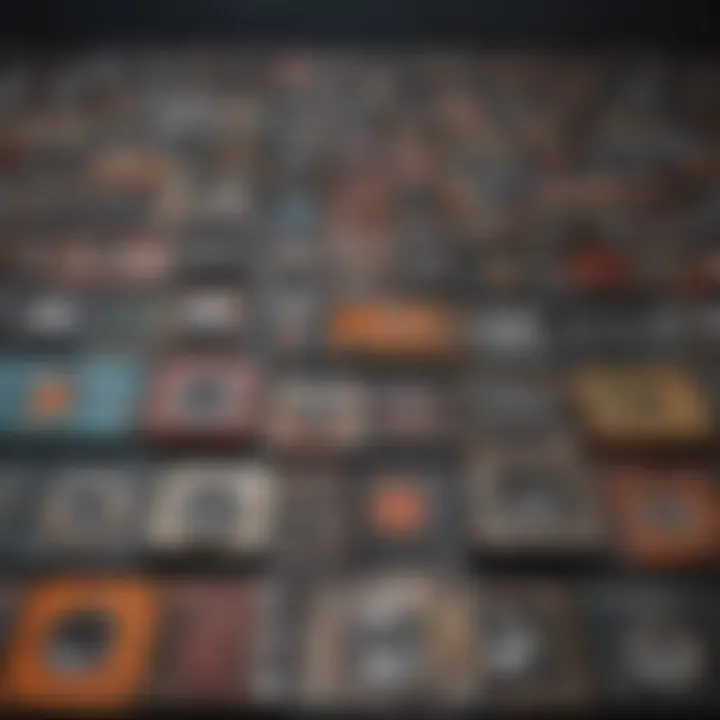The Impact of Metal Crush in Music Culture


Intro
The metal crush phenomenon represents a fascinating intersection of music, culture, and psychology, manifesting in a unique manner within the heavy metal community. It's more than just a fleeting infatuation for fans; it is a profound connection that ties listeners to the artists and communities surrounding them. This article explores the dynamic nature of metal crush, delving into its cultural significance, influence on fan behavior, and lasting impact on the music scene.
Metal, as a genre, is not just about the sound or the image; it encapsulates raw emotion, rebellion, and a sense of belonging. As fans engage deeply with the music, the phenomenon of metal crush emerges as a lens through which we can better understand their motivations, desires, and emotional responses. The raw power of metal music fosters an intimate bond that can be seen in the way fans connect with their favorite artists. Through this exploration, we hope to shine a light on how these crushes contribute to the ongoing evolution of the heavy metal genre itself.
Artist Profile
Biography and Background
To understand the metal crush phenomenon, one must first examine the artists behind the music. Take, for instance, M. Shadows, the charismatic frontman of Avenged Sevenfold. Born in 1981 in Huntington Beach, California, Shadows cultivated a passion for music during his teenage years. His distinct voice and commanding stage presence capture audiences, fostering a connection that many fans perceive as a deeper emotional bond.
An artist's background often plays a crucial role in shaping their musical identity. M. Shadows, with influences ranging from classic rock to punk, weaves stories of personal struggle and triumph into his lyrics, allowing listeners to relate on a profound level.
Major Influences and Inspirations
The creative sparks behind an artist's work can often shed light on the source of their charisma. Shadows often cites bands like Metallica and Iron Maiden as fundamental influences on his style. The blend of intricate guitar riffs, powerful lyrics, and theatrical performances can leave fans awestruck, further fueling the metal crush.
- Sound engineering techniques used by these giants inform new generations of bands.
- Their lyrical themes resonate in personal narratives, reflecting struggles and victories that fans find relatable.
- The presence of diverse stylistic influences can create a rich tapestry that captures listener's imaginations.
Song Analysis
Theme and Lyrics Breakdown
When examining specific songs, such as "Burn It Down,” the interplay of themes and lyrics is worth dissecting. The song presents a duality of emotion, speaking to themes of loss and redemption. Lyrics like "we rise from the ashes, unbroken and free" highlight resilience, which resonates with many fans facing their own challenges. This cathartic release can evoke strong feelings, intensifying the metal crush experience.
Instrumentation and Composition
The composition of metal tracks plays a pivotal role in how they impact listeners emotionally. The power chords, syncopated rhythms, and heavy distortion create a sonic landscape that is both exhilarating and immersive. For instance, the soaring guitar solos often bring a rush that listeners eagerly seek, solidifying their allegiance to the genre and the artists who create it.
- Guitars tend to carry the melody, driving the song forward, while drums anchor the piece with intensity.
- Vocal variations, often oscillating between melodic singing and aggressive screaming, can lead to an exhilarating listening experience.
- The juxtaposition of softer melodic elements against heavier segments provides a rollercoaster-like effect, leaving fans wanting more.
"In metal, every note seems to pierce the soul, creating a relationship that’s both powerful and personal."
Finale
In summation, the metal crush serves as a potent expression of how music intertwines with personal and cultural narratives. By understanding the artists, their influences, and the music itself, we can ascertain the gravity of the emotional bonds formed within this genre. As we move forward, it becomes increasingly vital to unravel these connections, providing insight not only into the metal community but also the broader scope of music culture as a whole.
Understanding Metal Crush
The phenomenon of metal crush cannot be understated when considering its impact on music culture. This article seeks to peel back the layers defining what it is, tracing its roots through history, and shining a light on its broader significance within society. Understanding metal crush provides insights not just into a seemingly niche subset of music fandom, but also illuminates the psychological and emotional connections that fans forge with metal music and its artists.
Definition of Metal Crush
Metal crush typically refers to a deep infatuation or admiration that fans feel towards metal musicians or bands. It transcends mere fandom, often intertwining with personal identity and emotional resonance. It’s more than just liking a band; it’s the kind of admiration that prompts fans to invest significantly—be it through attending concerts, gathering memorabilia, or even embracing the lifestyle associated with metal culture. Fans may experience a sense of belonging, finding solace and connection through shared musical experiences, often leading to a powerful, almost familial bond with fellow enthusiasts.
Historical Context
To understand where metal crush comes from, one must first look back at the evolution of metal music itself. Emerging in the late 1960s and early 1970s, bands like Black Sabbath and Led Zeppelin began crafting sounds that deviated from the mainstream. This era set the stage for future developments in metal music, cultivating a devoted fan base that would grow in size and passion. Over the years, genres like thrash, death, and power metal continued to capture the imaginations of listeners, each contributing to the overal tapestry of heavy metal. It was during the rise of these subgenres that the dynamics of metal crush started to flourish—as devoted fans gravitated towards artists who expressed their deepest feelings through often raw and aggressive sounds.
Cultural Significance
The cultural weight of metal crush is significant, reflecting broader societal currents and trends. Metal music often embraces themes of struggle, rebellion, and existentialism. Fans resonate with these themes, interpreting them as reflections of their own experiences. This connection fosters a sense of community—one in which individuals share similar struggles and derive strength through their alliance with metal.
Furthermore, the metal scene has historically been a subculture that promotes diversity and acceptance, albeit with contradictions. For many, being part of this distinct music culture gives them a voice, offering an avenue to express their identity in a world that often stifles individuality. In essence, metal crush is not merely an admiration for music; it serves as a lens through which one can navigate personal and communal realities.
"Metal, with its loud and chaotic sound, can often be a refuge for those seeking to express emotions that conventional society deems unacceptable."
In summary, understanding metal crush is essential to grasp how music influences human behavior and shapes cultural dynamics. It's not just about heavy riffs and powerful vocals; it's about forging identities, building communities, and resonating with deeply entrenched emotional journeys.
The Psychological Dimensions
Understanding the psychological dimensions of metal crush is crucial to grasping the breadth of its impact on both individual fans and the genre itself. This phenomenon is not just about music; it delves deep into emotional resonance, fan interactions, and personal identity within a community. Exploring these dimensions provides insights into why metal music evokes such passionate connections and how it shapes cultural narratives.
Emotional Connection
The emotional connection that fans cultivate with metal music is profound. It’s not merely about enjoying melodies or powerful guitar riffs; it goes beyond the surface to touch upon deeply held feelings. Listeners often find solace in lyrics that speak of struggle, rebellion, and the raw realities of life. Tracks like "Master of Puppets" by Metallica or "Iron Man" by Black Sabbath resonate with listeners who may grapple with their own life challenges. This cathartic experience allows individuals to process emotions.


- Resonance with Struggles: Many fans relate to themes of isolation and angst portrayed in metal songs. This connection often fosters a sense of belonging, knowing others share similar struggles.
- Community Through Emotion: The communal experience at concerts where thousands of voices join together in unison amplifies this emotional bond, creating a collective experience that feels intimate and personal.
- Soundtrack to Life: For many, these songs provide a chronicling of life events, serving as a backdrop for memorable moments—be it first loves, breakups, or personal victories.
Fandom Dynamics
Fandom in the metal scene is unique, characterized by a sense of loyalty that transcends typical music consumption. It becomes a lifestyle, rather than a pastime. Metal fans are often seen forming tight-knit communities, united by their shared passion for specific bands or subgenres.
- Active Participation: Fans routinely engage in discussions, whether online or in person, about their favorite artists, dissecting lyrics or sharing stories from concerts they’ve attended. This participatory culture is paramount—it's not only about listening but about engaging with the content.
- Cultural Significance of Merchandise: The act of wearing band t-shirts serves as a badge of honor. Fans don these symbols to express their allegiance and to identify with others in the metal community.
- Influence of Social Media: Platforms like Reddit and Facebook have made it easier for fans to connect and share. At times, these discussions evolve into movements, showcasing how a shared appreciation can lead to broader cultural discussions.
Identity Formation
For many fans, metal music is more than a genre; it’s a fundamental part of their identity. The aggressive sounds, intricate compositions, and the ethos surrounding metal foster an environment where listeners can explore and express their individuality.
- Defining Self through Metal: Individuals often find in metal an outlet to embrace aspects of themselves that might feel out of place in mainstream culture. Metal can be a refuge for those who feel marginalized or unheard.
- Transformation through Subculture: Adopting the aesthetics of metal culture—from fashion choices to music preferences—can contribute to one's self-image and confidence. This transformation creates a sense of belonging and validation.
- Engagement with Controversy: Metal, known for its provocative themes, encourages fans to confront societal norms. This push against the mainstream fosters discussions about culture, morality, and personal freedom, inviting listeners to think critically about their beliefs and the world around them.
"Metal music isn't just an escape; it's a mirror reflecting our struggles and aspirations, acting as both a shield and a sword."
In exploring the psychological dimensions of metal crush, we gain insight into the reasons behind its fervent fanbase and the enduring connection between artists and listeners. The emotional ties, dynamic fandom, and essential role it plays in identity formation together paint a vivid picture of metal's significance in today's cultural landscape.
Influence on Music Genres
When it comes to examining the impact of the metal crush phenomenon, one cannot overlook how it has shaped various music genres over time. Metal isn’t just a genre on its own; it’s a foundation upon which countless styles have built their identities, influencing everything from pop to jazz. The interconnections between metal and other genres often showcase a mutual respect that speaks volumes about the creative process in music. Here are some vital elements worth considering:
- Innovation: Genres influenced by metal often adopt its complexity and intricate composition, which can enhance musical depth.
- Collaboration: Musicians frequently find that melding different styles broadens their audience reach and opens up new creative avenues.
- Cultural Exchange: Music has this fascinating way of transcending borders; metal artists worldwide incorporate local flavors, fostering rich dialogues across cultures.
Heavy Metal and Its Subgenres
Heavy metal, in its raw form, establishes a solid backbone for numerous subgenres. Each offshoot bears distinctive traits and characteristics while maintaining an undeniable connection to heavy metal’s roots. For example, you have bands like Metallica and Slayer that thrive on aggressive shredding and powerful riffs, while Doom Metal, with its slower tempo and heavy atmosphere, offers a stark contrast but still feels like home in the metal family. Also, genres like Gothic Metal bring a blend of theatrical elements and dark themes that resonate with the angst and intensity of traditional metal. This diversity showcases how metal is adaptable; it naturally molds and evolves into new forms, catering to an array of listener preferences.
Cross-Genre Collaborations
Collaborations between metal artists and those from varied genres have resulted in fascinating hybrids. Take, for example, the work between hip-hop and metal. Bands like Rage Against the Machine have blurred the lines by marrying rap lyrics with heavy riffs, generating a sound that resonates across different demographics. Similarly, artists like Billie Eilish pay homage to metal influences in her darker tracks. These collaborations often ignite fresh interest in both genres, gathering diverse fanbases. The blending can lead to experiments that not only push the bounds of creative expression but also introduce listeners to sounds they might not encounter otherwise.
Evolution of Sound
Over time, metal music has undergone transformations, yet the essence remains firmly grounded in identity and emotion. From the raw power of 70s heavy metal to the polished production of modern styles, changes in technology are key players in this evolution. The arrival of digital recording and production tools has enabled artists to devise complex soundscapes, thereby enthralling listeners. Instruments like synthesizers and electronic elements have crept into metal, particularly in genres like Metalcore and Djent, creating a more dynamic listening experience. As artists play around with sounds and instrumentation, they offer fresh perspectives on what metal can be, continually expanding its horizons into the future.
"The beauty of metal lies in its ability to transform, incorporate, and transcend genres, creating a tapestry of sounds that tell the tales of countless experiences."
In summary, the influence of metal crush on music genres illustrates how adaptive and collaborative the landscape of music is. By bridging various styles and encouraging experimentation, the metal scene emphasizes the richness that comes from cultural exchange and innovation. The enduring legacy of metal resonates not only within its own subgenres but also branches into mainstream music, encouraging listeners to embrace a wide array of sounds.
Media Representation
In understanding the metal crush phenomenon, one cannot overlook the role that media representation plays. This encompasses the ways in which metal music and its culture are portrayed through various channels. This representation shapes perceptions, influences trends, and ultimately drives the community's image in society. Given its unique subculture, metal requires a nuanced exploration of how it has been depicted across various media platforms—from film and television to magazines, literature, and even digital platforms.
Film and Television
Film and television have served as potent vessels for portraying the metal music scene. Documentaries, feature films, and series often reflect the raw energy of metal, capturing its essence and cultural backdrop. For instance, This Is Spinal Tap, though a satire, illustrates the absurdity and enormity of rock culture, merging humor with the reality of life on the road.
On a more earnest note, documentaries like The Decline of Western Civilization Part II: The Metal Years provide an unfiltered glimpse into the lives of metal musicians. Such representations are essential because they foster a connection between fans and the artists. They highlight struggles, triumphs, and the distinct lifestyle that characterizes metal culture, which holds a mirror to the community, showing both its beauty and flaws.
What’s crucial to note is that metal music in film often engages with darker themes—rebellion, identity crises, and societal disillusionment. This can resonate deeply with viewers, evoking emotional responses and creating a sense of belonging among fans who see reflections of their own lives in the stories told.
Magazine and Literature
The relationship between metal music and printed media is characteristically symbiotic. Magazines like Metal Hammer and Rolling Stone have long been at the forefront of documenting the genre's evolution and supporting its artists. They not only feature interviews with musicians but also dive into critiques and analyses of the evolving sounds and lyrical content.
Literature, too, has embraced metal culture. Books such as Choosing Death: The Improbable History of Death Metal provide in-depth historical context and explore the intricate web of influences that shaped the genre. They offer a narrative that contextualizes metal crush, tracing its roots back to societal events and personal struggles that resonate with fans. This literary approach helps enrich the dialogue surrounding metal, adding layers to the discourse and fostering a deeper comprehension of its significance.
Digital Media and Online Platforms
In the age of digital media, the representation of metal has transformed dramatically. Platforms like YouTube and social media sites have revolutionized how fans engage with the music and artists. Viral music videos can create a fervor around new releases, while platforms like Reddit spawn discussions that dissect lyrics, sound, and the cultures surrounding various bands.
Beyond sharing music, these platforms allow fans to showcase their experiences, connecting through live session videos, reviews, and fan arts. This communal aspect enables fans to express their own identities in relation to their favorite artists.
Moreover, streaming services like Spotify curate playlists that feature not just popular metal songs but also highlight emerging bands, forging a new pathway for artists to reach listeners directly. This accessibility broadens the audience and democratizes representation in ways previously unimaginable.
By understanding how metal is represented in varied media forms, we can appreciate its influence not just on a musical level, but culturally and socially.
Thus, media representation of metal music is not merely a backdrop; it is a powerful force that shapes perceptions, creates communities, and ultimately defines the narrative of a genre that is both unique and complex.


Community and Social Aspects
The impact of community and social aspects within the metal crush phenomenon cannot be overstated. This facet serves as a crucial pillar supporting the extensive network of fans, artists, and cultural exchange that characterizes the metal music landscape. The sense of belonging created through shared musical passion influences personal identity, fosters loyalty, and shapes attitudes towards life and art. Engaging with community elements enriches the metal experience and propels the genre further into mainstream conversations.
Concert Culture
Concerts are the lifeblood of metal culture, embodying what it truly means to be part of the community. Attending live performances not only allows fans to experience music in its rawest form, but it also generates a unique atmosphere that fosters collective emotional responses. Fans gather to scream, headbang, and bond over their favorite bands, often melting personal boundaries and creating connections that last long after the final note has faded.
The significance of concert culture in shaping the metal crush phenomenon includes:
- Shared Experience: Whether it’s the thrill of a mosh pit or a slower, more somber moment during a ballad, the collective experience of a concert heightens individual emotions.
- Celebration of Subculture: These gatherings provide a platform for showcasing the various subcultures within metal, from thrash to doom, and everything in between. Each performance displays the diverse musical influences and styles of the metal genre.
- Networking Opportunities: For aspiring musicians and fans alike, concerts act as networking hubs where connections can blossom into profound friendships or collaborative projects.
"Live shows aren't just concerts; they are the epicenters of metal culture that bring people from all walks of life together."
Online Fan Communities
As technology continues to evolve, the online fan communities have burgeoned, allowing metal enthusiasts to connect in ways that were previously unimaginable. Platforms such as Reddit and Facebook have given fans a voice, a space to share their thoughts, experiences, and feels about every nook and cranny of the metal scene. Here’s how these communities create a vibrant digital landscape:
- Facilitation of Discussion: Fans share insights, reviews, and analyses of albums and concerts, creating an ongoing dialogue that stimulates appreciation for the craft.
- Support Networks: Many find solace in groups where shared struggles are acknowledged and understood, thus reinforcing the notion of solidarity.
- Accessibility to Information: Knowledge about events, album releases, and discussions about artists becomes easily accessible, allowing fans to stay in the know.
The virtual world acts as a stage for fans to connect with each other, often leading to real friendships and collaborations.
Charity and Activism
The metal community often takes on social responsibility, rallying together for important causes. Metal festivals and concerts frequently include components designed to raise awareness and funds for charity work. This activism underscores a critical aspect of the genre's identity, uniting fans not just through music, but through action:
- Fundraising Events: Many bands and local groups organize benefits that channel the resources of the metal community into tangible support for causes like mental health, addiction recovery, or disaster relief.
- Awareness Campaigns: Metal artists frequently use their platforms to advocate for social issues such as inequality, climate change, or human rights, resonating deeply with fans who share those concerns.
- Empowerment of Fans: This grassroots activism empowers fans to engage with their community and the world at large, often inspiring them to take similar initiative in their own lives.
In this complex web of community dynamics, metal culture transcends mere musical enjoyment, fostering relationships based on shared values and collective endeavors.
Case Studies of Iconic Artists
In examining the metal crush phenomenon, the study of iconic artists is pivotal. These figures serve as touchstones for the genre, each providing unique contributions that shape not only the music but also the culture surrounding it. By looking into the artists who have profoundly influenced the world of metal, we can uncover various elements that contribute to the metal crush experience—elements like sound innovation, lyrical depth, and stage persona. Understanding these artists allows fans and enthusiasts alike to discern the layers present in metal music and its community.
Influential Metal Bands
Influential metal bands have left indelible marks on music history, solidifying their places in the hearts of fans. One such band is Metallica, whose 1986 album "Master of Puppets" is often deemed a crucial turning point in the genre. With intricate compositions, shifting dynamics, and raw emotion, they encapsulated the essence of metal crush even as they invited broader audiences to engage with their sound. Similarly, Black Sabbath symbolizes the birth of heavy metal itself. Their dark thematic elements and heavy riffs not only pioneered numerous subgenres but also allowed fans, through shared experiences, to find solace and identity in the music.
- Metallica: 'The Unforgiven'
This track exemplifies emotional storytelling through music, resonating with themes of struggle and isolation, profoundly impacting fans across generations. - Black Sabbath: 'Paranoid'
A defining anthem that captures a sense of angst and rebellion, sparking a movement that continues to inspire new artists today.
Solo Artists and Their Impact
In contrast to the collaborative nature of bands, solo artists in the metal scene bring a unique flavor to the genre. Figures like Ozzy Osbourne and Rob Zombie have made significant contributions that emphasize personal artistry. Ozzy, often called the Prince of Darkness, brings vulnerability through his songwriting, allowing listeners a glimpse into his struggles. His songs often reflect experiences that resonate with fans, creating a tight-knit connection.
Rob Zombie, with his theatrical prowess and horror aesthetics, stretches the boundaries of metal into visual arts and cultural commentary. This crossover illustrates how solo artists in metal can reshape traditional perceptions and expand the narrative of metal crush beyond mere sound.
"Music is not just sound; it connects us to our own stories."
- Anonymous
Emerging Artists Reshaping Metal
A new wave of artists is invigorating the metal scene, challenging conventions while keeping the spirit of metal alive. Bands like Spiritbox and solo acts like Babymetal have garnered attention for their innovative approaches and genre-blending styles.
Spiritbox combines haunting melodies with brutal riffs, engaging a diverse audience by addressing mental health challenges and personal experiences directly in their lyrics. Their breakout track, "Holy Roller," showcases a thrilling juxtaposition between quiet introspection and explosive energy that captures the essence of modern metal crush.
On the other hand, Babymetal transcends boundaries by fusing heavy metal with J-pop. This synthesis creates a unique spectacle that resonates with both metalheads and pop lovers. The sheer novelty of their approach draws in a wide audience and highlights how emerging artists reshape the metal landscape, making it relevant for future generations.
- Spiritbox: 'Holy Roller'
A powerful anthem that bids farewell to silence and embraces the chaos, making it a staple in the playlists of many new fans. - Babymetal: 'Gimme Chocolate!!'
This track invites listeners to experience heavy riffs enveloped in playful pop culture, showcasing the diversity that metal can embrace.
Through these case studies of iconic artists, we see not only the roots of metal crush but also its evolution. Each artist, band, or emerging talent brings forth a unique narrative, contributing to a larger story that intertwines personal experiences, cultural commentary, and collective identity.
Global Perspectives
In the realm of metal music, it's essential to cast a wide net and explore its global perspectives. Understanding how metal transcends boundaries gives insights into its immense diversity and adaptability. Each corner of the globe has embraced metal in a unique way, leading to an intricate tapestry of cultures, sounds, and communities. By looking across countries and continents, we find not only how metal is consumed but also why it resonates so deeply with audiences. The relevance of a global outlook lies in appreciating these various interpretations and styles, showcasing the power of music to unite disparate voices.
Metal Scenes around the World
When one mentions metal music, many think of Western bands like Metallica or Iron Maiden. However, dive deeper and you'll uncover rich metal scenes in places you might not expect.


- Scandinavian Metal: Countries like Sweden and Finland have spawned a wealth of metal subgenres, from melodic death metal to black metal. Bands like Arch Enemy and Nightwish are not just local heroes; they’ve painted the global metal canvas with their talent.
- Latin American Metal: The vibrant metal scenes in countries like Brazil and Mexico showcase a fusion of local culture with metal. Bands such as Sepultura and Brujeria incorporate elements of their heritage. This blend creates a unique sound that resonates with local and international fans alike.
- Asian Metal: In Japan, bands like Babymetal have redefined metal with an innovative mix of pop and heavy music, challenging traditional norms. Meanwhile, India’s metal scene has been gaining traction, with acts like Bhayanak Maut pushing the envelope and breaking into the global spotlight.
The benefit of examining these diverse scenes is that it allows for a fuller understanding of how metal evolves and interacts with local cultures. Each region adds its own flavor, forming an intricate network of influences that shape the genre.
Cultural Exchanges in Metal Music
Cultural exchanges in metal are not just a byproduct of globalization; they are vital to the genre's evolution. With the rise of the internet and social media, musicians and fans can share their passions instantaneously, breaking down barriers that once seemed insurmountable.
Consider this:
- Collaborations across continents can yield some groundbreaking tracks, as seen with the partnership between Western metal artists and traditional musicians from various cultures. This not only refreshes the sound but broadens the listener's horizon.
- Exposure to different styles can breathe new life into a musician’s work, pushing them to experiment and grow in ways they might not have imagined.
The ability to blend different musical traditions has led to unique subgenres and unexpected collaborations which further enrich the metal landscape.
International Festivals and Events
International festivals serve as a stage where cultures collide and collaborate, making them essential to the metal ecosystem. Events like Wacken Open Air in Germany or Download Festival in the UK attract a global crowd.
- Cultural Melting Pot: These festivals bring together fans and artists from various backgrounds. You might find fans from Japan jamming out alongside metal enthusiasts from Brazil. This cross-pollination fosters a sense of community and builds bonds that transcend geographical limitations.
- Spotlighting Emerging Talent: Some festivals are dedicated to showcasing local talent, giving emerging artists an opportunity to share the stage with renowned bands. This not only promotes their music but also encourages a new generation to engage with the metal scene.
Attending these events often leads to a shared sense of identity and belonging. Fans leave with memories, connections, and fresh perspectives on the music that they love.
"Metal is a universal language that speaks to the heart of humanity, irrespective of borders or traditions."
Future Trends in Metal Crush
The world of metal music, often perceived as a steadfast genre, is witnessing promising shifts that could redefine the fabric of its culture and community. Understanding these future trends is crucial because they reflect not only the evolving tastes of audiences but also the adaptation of artists to a fast-paced, digital world. With this in mind, we delve into three pivotal elements: technological advancements, changing audience demographics, and the role of streaming services. Each of these components represents a unique player in the grand orchestration of the metal crush phenomenon, potentially shaping its trajectory in the years to come.
Technological Advancements
Technology in music has always been a double-edged sword. On one side, it disrupts traditional methods, while on the other, it opens up endless pathways for innovation. In metal, new tools for music production allow artists to experiment with sound in ways that were previously unimaginable. Artists like ChuggaBuggaMetals are employing advanced software to manipulate audio, pushing the limits of heavy riffs and virtuosic solos. The use of AI-driven composition tools has also gained traction, where musicians harness algorithms to create complex arrangements, offering fresh content and enhancing creativity.
"The very essence of metal is rebellion—against norms, against mediocrity. Today, tech is the new rebellion."
- A quote from Guitar Magazine author, emphasizing the relationship between technology and metal's ethos.
The impact of virtual reality concerts has been another significant advancement. With companies developing immersive experiences, fans can attend concerts from their homes, witnessing performances as if they were in the front row. This not only democratizes access but also brings unique interactions that were once limited to physical events.
Changing Audience Demographics
The face of the metal audience is not static; it shifts and morphs, influenced by trends, societal changes, and cultural discourse. Younger generations, increasingly diverse, are leading a crossover between traditional metal and other genres, such as hip-hop and electronic music. This blending doesn’t dilute the genre but instead enriches its essence, creating a hybrid culture that resonates deeply with today's listeners.
The idea of representation in metal is becoming a conversation starter. Historically, the metal scene often reflected a narrow spectrum of voices. However, with more female and minority artists entering the scene, they are broadening its appeal and diversifying narratives. Bands like Spiritbox and Sepultura are not just popular for their music; they signify a shift toward inclusivity and representation in all its forms.
The Role of Streaming Services
In an era where music consumption is dominated by streaming platforms, the way metal interacts with its listeners has undergone a revolution. Services like Spotify and Apple Music facilitate easy access to a vast array of metal subgenres, allowing even niche communities to thrive. Playlists curated around themes or moods let users discover deep cuts alongside mainstream hits, which contributes to a broader appreciation of metal as a multifaceted genre.
The algorithms that power these platforms can turn an underground band into a household name overnight, fostering a unique sense of community and discovery. For instance, when Black Midi burst onto the scene, it was largely through recommendations on streaming platforms that it reached diverse audiences. Artists are realizing that their success today is not solely from album sales but from streaming metrics—a complete paradigm shift in how fame and validation in music operates.
In summary, the future of metal crush encapsulates an intricate interplay of technology, audience evolution, and media consumption. As we explore these dimensions, it's clear that while the foundation of metal music remains deeply rooted, its branches are stretching toward an uncharted territory, promising to reshape the landscape for generations to come.
Concluding Insights
In discussing the concept of metal crush, we arrive at a pivotal juncture, one that encapsulates the tumultuous yet passionate relationship between music and its audience. The significance of this section lies in its ability to distill the essence of what metal crush represents, not just as a mere musical phase but as a rich cultural phenomenon that shapes identities, community bonds, and artistic expressions. By examining its roots, influences, and projections for the future, we can appreciate the various nuances contributing to its enduring appeal.
The Enduring Appeal of Metal Crush
The magnetic draw of metal crush can be attributed to the genre’s raw energy and authenticity. Music that resonates, speaks to deep-seated emotions, and sometimes coaxes cathartic releases stands tall in popularity. Many fans find solace in heavy riffs, shouted lyrics, and aggressive yet melodic sounds. It’s as if metal is a voice for those feelings that often go unexpressed or are too difficult to articulate.
This appeal isn’t merely auditory. The visual aesthetics tied to heavy metal—from striking album artwork to elaborate stage setups—add layer upon layer to the experience. Fans form emotional investments in bands through imagery, fashion, and the community that arises around shared experiences. The ritualistic nature of attending concerts and engaging in fandom deepens these connections.
"Metal isn't just a sound; it’s a lifestyle. It's a culture that embraces every part of life’s strife." - Anonymous Metalhead
Metal Crush in Cultural Discourse
Metal crush intersects importantly with wider cultural conversations. It challenges norms and often confronts societal issues head-on. Through powerful lyrics, bands highlight everything from personal struggles to larger socio-political themes. Artists like Rage Against the Machine have leveraged their music as a platform for activism, urging listeners to think critically about the world around them.
These narratives foster community solidarity among fans. Engaging in discussions about the topics represented in metal songs becomes an entry point for dialogues around mental health, social justice, and personal empowerment. The global nature of the metal community amplifies these discussions, with fans from diverse backgrounds sharing their interpretations and experiences. The resulting tapestry of voices expands the cultural discourse surrounding metal music.
Reflections on Metal's Future
As we ponder the future of metal crush, several factors come into play. The advent of streaming services has transformed how music is consumed, allowing even niche genres to find their audience without being confined to traditional channels. This accessibility means that new artists can thrive by finding listeners outside their geographical limitations.
Furthermore, changing demographics indicate a bright future for metal. Younger generations, equipped with fresh perspectives and an ever-evolving cultural landscape, embrace the genre while adding their unique flavors. This revitalization may breathe new life into subgenres and might even lead to innovative soundscapes.







